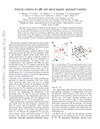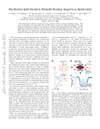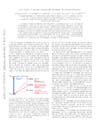News

Sofus Laguna Kristensen just joined our group as a postdoc. Welcome Sofus!

Akhil Kumar just joined our group as a PhD student. Welcome Akhil!

Our paper Long-Lived Coherence on a μHz Optical Magnetic Quadrupole Transition was just published in Physical Review Letters as an Editor’s suggestion.
As usual, the paper is also available on the Physics arXiv.

Our paper Fine-Structure Qubit Encoded in Metastable Strontium Trapped in an Optical Lattice was just published in Physical Review Letters.
As usual, the paper is also available on the Physics arXiv.

Saumya Shah just joined our group as a Masters student. Welcome Saumya!

We demonstrate coherent control of the fine-structure qubit in neutral strontium atoms. This qubit is encoded in the metastable ³P₂ and ³P₀ states, coupled by a Raman transition. Using a magnetic quadrupole transition, we demonstrate coherent state-initialization of this THz qubit. We show Rabi oscillations with more than 60 coherent cycles and single-qubit rotations on the μs scale. With spin-echo, we demonstrate coherence times of tens of ms. Our results pave the way for fast quantum information processors and highly tunable quantum simulators with two-electron atoms.
Have a look at our preprint on the Physics arXiv.

We report on the coherent excitation of the ultranarrow ¹S₀-³P₂ magnetic quadrupole transition in 88Sr. By confining atoms in a state insensitive optical lattice, we achieve excitation fractions of 97(1)% and observe linewidths as narrow as 58(1) Hz. With Ramsey spectroscopy, we find coherence times of 14(1) ms, which can be extended to 266(36) ms using a spin-echo sequence. We determine the linewidth of the M2 transition to 24(7) μHz, confirming longstanding theoretical predictions. These results establish an additional clock transition in strontium and pave the way for applications of the metastable ³P₂ state in quantum computing and quantum simulations.
Have a look at our preprint on the Physics arXiv.

Jan Geiger just joined our group as a PhD student. Welcome Jan!

Klavdia Kontou just joined our group as a Masters student. Welcome Klavdia!

Ka Hui Goh just joined our group as a Masters student. Welcome Ka Hui!

Andreas Schindewolf just joined our group as a Postdoc. Welcome Andreas!

Our paper ¹S₀-³P₂ magnetic quadrupole transition in neutral strontium was just published in Physical Review Research.
As usual, the paper is also available on the Physics arXiv.